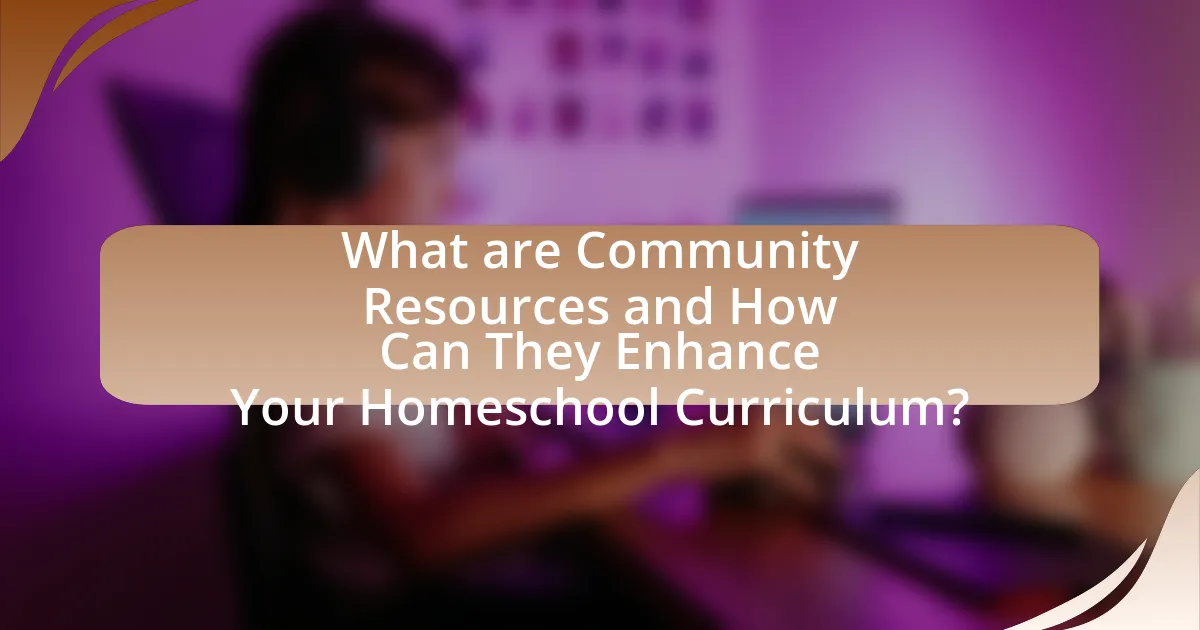Community resources play a vital role in enhancing homeschool curricula by providing access to educational support, specialized programs, and extracurricular activities. This article explores the various types of community resources available to homeschoolers, including libraries, museums, and local organizations, and discusses their benefits in improving student engagement, academic performance, and social skills. It also outlines strategies for identifying and effectively incorporating these resources into homeschooling practices, emphasizing the importance of community involvement in fostering a well-rounded educational experience. Additionally, the article addresses common challenges faced when utilizing community resources and offers solutions to maximize their benefits for homeschooling families.

What are Community Resources and How Can They Enhance Your Homeschool Curriculum?
Community resources are local organizations, facilities, and services that provide educational support and enrichment opportunities for homeschoolers. These resources can enhance a homeschool curriculum by offering access to specialized programs, workshops, and extracurricular activities that align with educational goals. For instance, local libraries often provide free access to books, online databases, and educational events, while community centers may offer classes in arts, sciences, or sports. Research indicates that utilizing community resources can improve student engagement and learning outcomes, as they provide real-world experiences and social interactions that are essential for holistic education.
Why should homeschoolers consider using community resources?
Homeschoolers should consider using community resources to enhance their educational experience and provide diverse learning opportunities. Community resources, such as libraries, museums, and local organizations, offer access to specialized programs, workshops, and materials that can enrich the homeschool curriculum. For instance, a study by the National Center for Education Statistics found that students who engage with community resources demonstrate improved academic performance and social skills. By leveraging these resources, homeschoolers can create a more well-rounded and engaging learning environment.
What types of community resources are available for homeschoolers?
Community resources available for homeschoolers include local libraries, community centers, co-ops, museums, and extracurricular programs. Libraries often provide access to educational materials, workshops, and events tailored for children. Community centers may offer classes and activities that support various subjects, while co-ops allow homeschoolers to collaborate on lessons and share resources. Museums frequently host educational programs and field trips that align with curriculum goals, enhancing hands-on learning experiences. Extracurricular programs, such as sports teams and arts classes, further enrich the homeschool experience by providing social interaction and skill development.
How can community resources complement traditional homeschooling methods?
Community resources can enhance traditional homeschooling methods by providing access to diverse educational experiences and social interactions. These resources include local libraries, museums, community centers, and extracurricular programs that offer specialized classes or workshops. For instance, a study by the National Center for Education Statistics found that 25% of homeschooling families utilize community resources to supplement their curriculum, indicating a significant trend towards integrating external educational opportunities. By leveraging these resources, homeschooling families can enrich their learning environment, foster community engagement, and provide students with hands-on experiences that align with their educational goals.
What are the benefits of integrating community resources into your curriculum?
Integrating community resources into your curriculum enhances educational relevance and engagement. By utilizing local organizations, businesses, and cultural institutions, students gain real-world experiences that connect classroom learning to their community. Research indicates that students who engage with community resources demonstrate improved academic performance and increased motivation. For example, a study by the National Education Association found that students involved in community-based learning programs showed a 20% increase in academic achievement compared to their peers. This integration fosters a sense of belonging and responsibility, encouraging students to become active participants in their communities.
How do community resources foster socialization among homeschoolers?
Community resources foster socialization among homeschoolers by providing structured environments where children can interact with peers and engage in collaborative activities. These resources, such as local libraries, community centers, and extracurricular programs, offer opportunities for group learning, sports, and arts, which are essential for developing social skills. For instance, participation in community sports teams or art classes allows homeschoolers to build friendships and learn teamwork, enhancing their social development. Research indicates that children who engage in community activities exhibit improved social skills and emotional well-being, demonstrating the effectiveness of these resources in promoting socialization among homeschoolers.
What skills can students develop through community engagement?
Students can develop critical skills such as communication, teamwork, problem-solving, and leadership through community engagement. Engaging with diverse groups in community projects enhances their ability to articulate ideas and collaborate effectively. For instance, participating in local service initiatives fosters problem-solving skills as students encounter real-world challenges and work towards solutions. Additionally, taking on roles in community organizations allows students to practice leadership, as they often need to guide peers or coordinate activities. Research indicates that students involved in community service report higher levels of social responsibility and civic engagement, which further supports the development of these essential skills.

How Can You Identify and Access Community Resources?
To identify and access community resources, individuals can start by researching local organizations, libraries, and educational institutions that offer programs or services relevant to homeschooling. Community centers often provide information on workshops, classes, and events that can enhance the curriculum. Additionally, online platforms and social media groups focused on homeschooling can connect families with local resources and support networks. According to the National Center for Education Statistics, 3.7 million students were homeschooled in the United States in 2020, highlighting the growing need for accessible community resources to support these learners.
What steps should you take to find local community resources?
To find local community resources, start by researching online directories and local government websites that list available services and organizations. These platforms often provide comprehensive information about community centers, libraries, and educational programs. Additionally, visiting local libraries can yield valuable resources, as they typically have bulletin boards and staff knowledgeable about community offerings. Engaging with local social media groups or forums can also connect you with other families and educators who share insights on available resources. Finally, attending community events allows for networking and discovering resources firsthand, as many organizations promote their services at these gatherings.
How can libraries and museums serve as valuable resources?
Libraries and museums serve as valuable resources by providing access to a wealth of information, educational programs, and cultural experiences that enhance learning. Libraries offer a vast collection of books, digital resources, and research materials, which support diverse subjects and foster literacy. For instance, the American Library Association reports that libraries provide over 1.3 billion physical and digital items annually, facilitating research and learning for all ages. Museums, on the other hand, offer hands-on experiences and exhibitions that bring subjects to life, promoting critical thinking and creativity. According to the Institute of Museum and Library Services, museums engage over 850 million visitors each year, providing educational programs that align with school curricula and support experiential learning. Together, libraries and museums enrich the educational landscape, making them essential resources for homeschooling families.
What role do local organizations and clubs play in supporting homeschoolers?
Local organizations and clubs play a crucial role in supporting homeschoolers by providing resources, socialization opportunities, and educational activities. These organizations often offer workshops, field trips, and group classes that enhance the homeschooling experience, allowing students to engage in hands-on learning and collaborate with peers. For instance, many local clubs facilitate co-op classes where families can share teaching responsibilities, thus enriching the curriculum with diverse subjects and teaching styles. Additionally, these organizations foster a sense of community among homeschoolers, which is vital for social development and emotional support. Research indicates that participation in community groups can significantly improve educational outcomes for homeschoolers by providing structured learning environments and access to expert-led instruction.
How can online resources enhance your search for community support?
Online resources can significantly enhance your search for community support by providing access to a wide range of information, networks, and tools that connect individuals with local organizations and services. These resources include online directories, social media groups, and educational platforms that facilitate communication and collaboration among homeschooling families and community support entities. For instance, platforms like Facebook and Meetup allow users to find local homeschooling groups, while websites such as Homeschool.com offer directories of resources and support networks tailored to specific needs. Research indicates that 70% of homeschooling families utilize online resources to connect with community support, demonstrating their effectiveness in fostering collaboration and enhancing educational experiences.
What websites and platforms are best for connecting with local resources?
The best websites and platforms for connecting with local resources include Nextdoor, Facebook Groups, and Meetup. Nextdoor allows users to engage with their immediate neighborhood, facilitating connections with local services and events. Facebook Groups provide a platform for community members to share resources, events, and support, often tailored to specific interests or locations. Meetup focuses on bringing people together for shared activities, making it easy to find local events and groups that align with educational interests. These platforms are widely used and effective for accessing community resources relevant to homeschooling.
How can social media groups assist in finding community resources?
Social media groups can assist in finding community resources by providing a platform for members to share information, recommendations, and experiences related to local services and opportunities. These groups often consist of individuals who are familiar with the community, allowing for real-time discussions and updates about resources such as educational programs, tutoring services, and extracurricular activities. For instance, a study by Pew Research Center indicates that 69% of adults in the U.S. use social media, making it a significant avenue for community engagement and resource sharing. This connectivity enables users to quickly access and disseminate valuable information, enhancing the ability to locate and utilize community resources effectively.

What Strategies Can You Use to Effectively Incorporate Community Resources?
To effectively incorporate community resources into a homeschool curriculum, families can utilize partnerships with local organizations, engage in community service projects, and leverage local libraries and educational programs. Establishing partnerships with local organizations, such as museums, art centers, and science institutions, allows for hands-on learning experiences that align with curriculum goals. Engaging in community service projects not only teaches social responsibility but also provides practical applications of academic concepts. Additionally, local libraries often offer free workshops, reading programs, and access to educational materials, which can enhance learning opportunities. These strategies are supported by research indicating that community involvement significantly enriches educational experiences and fosters a sense of belonging and responsibility among students.
How can you create a balanced curriculum using community resources?
To create a balanced curriculum using community resources, educators should integrate local organizations, libraries, and businesses into the learning framework. This approach allows for diverse educational experiences that reflect real-world applications and community values. For instance, partnering with local museums can provide hands-on learning opportunities that enhance subjects like history and science, while collaboration with local businesses can offer insights into economics and entrepreneurship. Research indicates that students who engage with community resources demonstrate improved academic performance and social skills, as evidenced by a study published in the “Journal of Educational Psychology,” which found that community involvement positively impacts student engagement and learning outcomes.
What are some examples of lesson plans that integrate community resources?
Examples of lesson plans that integrate community resources include a local history project where students research and present on significant historical sites in their town, utilizing local libraries and historical societies for resources. Another example is a science lesson that involves a field trip to a nearby nature reserve, where students can observe ecosystems firsthand and engage with park rangers for expert insights. Additionally, a community service project can be incorporated into a social studies curriculum, where students partner with local charities to understand social issues and contribute through volunteer work. These lesson plans effectively leverage community resources to enhance learning experiences and provide real-world context.
How can field trips enhance the learning experience?
Field trips enhance the learning experience by providing hands-on, real-world engagement that reinforces classroom concepts. This experiential learning allows students to connect theoretical knowledge with practical applications, fostering deeper understanding and retention. Research indicates that students who participate in field trips demonstrate improved critical thinking skills and greater enthusiasm for learning, as evidenced by a study published in the Journal of Educational Psychology, which found that 90% of students reported increased interest in the subject matter after a field trip. Additionally, field trips promote social interaction and teamwork, further enriching the educational experience.
What are best practices for collaborating with community organizations?
Best practices for collaborating with community organizations include establishing clear communication, setting mutual goals, and fostering trust. Clear communication ensures that all parties understand their roles and expectations, which is essential for effective collaboration. Setting mutual goals aligns the objectives of both the community organization and the homeschooling group, facilitating a shared vision for the partnership. Fostering trust through transparency and consistent engagement builds a strong foundation for ongoing collaboration. Research indicates that partnerships with community organizations can enhance educational outcomes, as evidenced by a study published in the “Journal of Community Engagement and Scholarship,” which found that collaborative efforts significantly improved student learning experiences.
How can you establish partnerships with local businesses and nonprofits?
To establish partnerships with local businesses and nonprofits, initiate by identifying organizations that align with your educational goals and values. Research their missions and community involvement to ensure compatibility. Next, reach out with a clear proposal outlining mutual benefits, such as offering workshops, resources, or volunteer opportunities that enhance both your homeschool curriculum and their community engagement. For instance, a study by the National Network of Partnership Schools indicates that schools collaborating with local businesses see improved student outcomes and community support. This evidence supports the effectiveness of such partnerships in enriching educational experiences.
What should you consider when planning community-based projects?
When planning community-based projects, you should consider the needs and interests of the community, available resources, and potential partnerships. Understanding community needs ensures that the project addresses relevant issues, while assessing available resources, such as funding, facilities, and volunteers, helps in realistic planning. Additionally, forming partnerships with local organizations can enhance project reach and effectiveness. Research indicates that community engagement increases project success rates, as seen in studies like “Community-Based Participatory Research: A Strategy for Building Healthy Communities” by Israel et al., which highlights the importance of collaboration in achieving sustainable outcomes.
What tips can help you maximize the benefits of community resources?
To maximize the benefits of community resources, actively engage with local organizations and programs that align with your educational goals. Participation in workshops, classes, and events offered by libraries, museums, and community centers can provide valuable learning experiences. Research shows that families who utilize community resources report improved educational outcomes, as these resources often offer specialized knowledge and hands-on activities that enhance the homeschooling experience. For instance, a study by the National Home Education Research Institute indicates that homeschoolers who integrate community resources into their curriculum tend to have higher academic performance and social skills.
How can you encourage student participation in community activities?
To encourage student participation in community activities, educators can create partnerships with local organizations that offer volunteer opportunities tailored to students’ interests. Research indicates that students who engage in community service are more likely to develop a sense of civic responsibility and improve their social skills. For instance, a study by the Corporation for National and Community Service found that students who participate in service-learning programs show higher academic performance and increased engagement in school. By integrating these community activities into the homeschool curriculum, educators can provide practical experiences that enhance learning and foster a commitment to community involvement.
What are common challenges when using community resources, and how can you overcome them?
Common challenges when using community resources include limited access, lack of awareness, and scheduling conflicts. Limited access can arise from geographical barriers or insufficient transportation options, which can be overcome by utilizing online resources or arranging carpools with other families. Lack of awareness about available resources can be addressed through community outreach programs or local homeschooling networks that share information. Scheduling conflicts often occur due to differing availability among families; this can be mitigated by establishing a flexible schedule that accommodates various participants or by prioritizing resources that offer multiple time slots.










